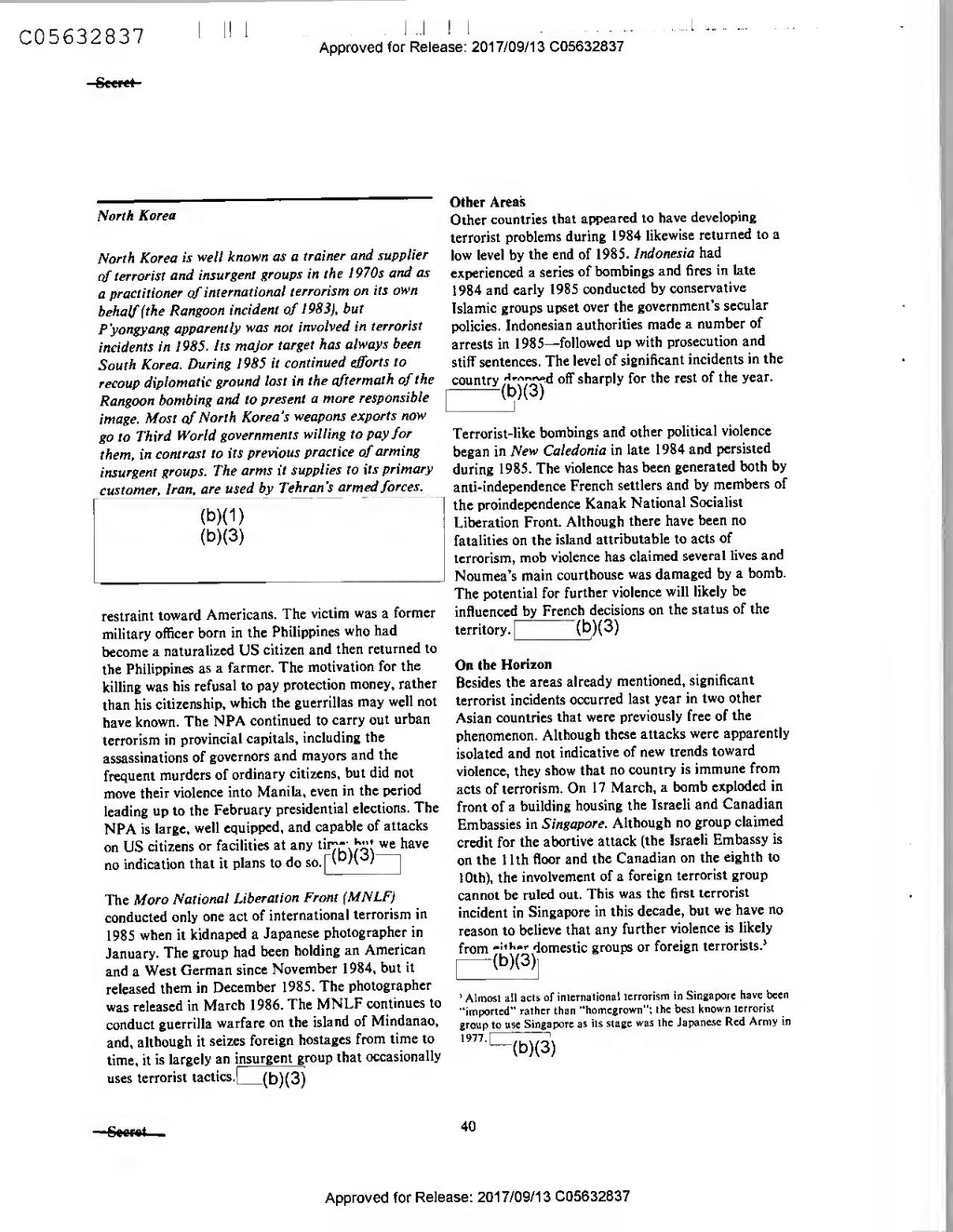Secret
North Korea
North Korea is well known as a trainer and supplier of terrorist and insurgent groups in the 1970s and as a practitioner of international terrorism on its own behalf (the Rangoon incident of 1983), but P'yongyang apparently was not involved in terrorist incidents in 1985. Its major target has always been South Korea. During 1985 it continued efforts to recoup diplomatic ground lost in the aftermath of the Rangoon bombing and to present a more responsible image. Most of North Korea's weapons exports now go to Third World governments willing to pay for them, in contrast to its previous practice of arming insurgent groups. The arms it supplies to its primary customer, Iran, are used by Tehran's armed forces.
(b)(1) (b)(3)
Other Areas Other countries that appeared to have developing terrorist problems during 1984 likewise returned to a low level by the end of 1985. Indonesia had experienced a series of bombings and fires in late 1984 and early 1985 conducted by conservative Islamic groups upset over the government's secular policies. Indonesian authorities made a number of arrests in 1985—followed up with prosecution and stiff sentences. The level of significant incidents in the country connod off sharply for the rest of the year.
(b)(3)
Terrorist-like bombings and other political violence began in New Caledonia in late 1984 and persisted during 1985. The violence has been generated both by anti-independence French settlers and by members of the proindependence Kanak National Socialist Liberation Front. Although there have been no fatalities on the island attributable to acts of terrorism, mob violence has claimed several lives and Noumea's main courthouse was damaged by a bomb. The potential for further violence will likely be influenced by French decisions on the status of the territory. (b)(3)
restraint toward Americans. The victim was a former military officer born in the Philippines who had become a naturalized US citizen and then returned to the Philippines as a farmer. The motivation for the killing was his refusal to pay protection money, rather than his citizenship, which the guerrillas may well not have known. The NPA continued to carry out urban terrorism in provincial capitals, including the assassinations of governors and mayors and the frequent murders of ordinary citizens, but did not move their violence into Manila, even in the period leading up to the February presidential elections. The NPA is large, well equipped, and capable of attacks on US citizens or facilities at any time: hut we have no indication that it plans to do so.
- (b)(3)
On the Horizon Besides the areas already mentioned, significant terrorist incidents occurred last year in two other Asian countries that were previously free of the phenomenon. Although these attacks were apparently isolated and not indicative of new trends toward violence, they show that no country is immune from acts of terrorism. On 17 March, a bomb exploded in front of a building housing the Israeli and Canadian Embassies in Singapore. Although no group claimed credit for the abortive attack (the Israeli Embassy is on the 11th floor and the Canadian on the eighth to 10th), the involvement of a foreign terrorist group cannot be ruled out. This was the first terrorist incident in Singapore in this decade, but we have no reason to believe that any further violence is likely from either domestic groups or foreign terrorists.'
(b)(3)
The Moro National Liberation Front (MNLF) conducted only one act of international terrorism in 1985 when it kidnaped a Japanese photographer in January. The group had been holding an American and a West German since November 1984, but it released them in December 1985. The photographer was released in March 1986. The MNLF continues to conduct guerrilla warfare on the island of Mindanao, and, although it seizes foreign hostages from time to time, it is largely an insurgent group that occasionally uses terrorist tactics.
(b)(3)
Almost all acts of international terrorism in Singapore have been "imported" rather than "homegrown"; the best known terrorist group to use Singapore as ils stage was the Japanese Red Army in 1977.
(b)(3)
Secret
40
Approved for Release: 2017/09/13 C05632837
